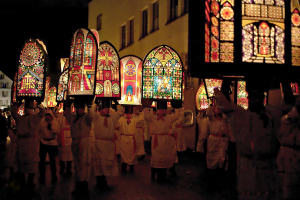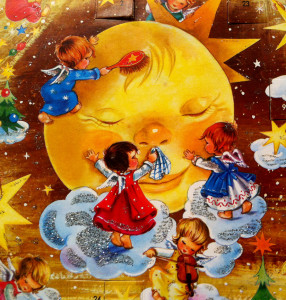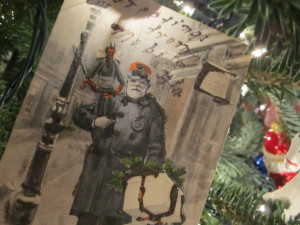I have long suspected that Americans just don’t have as much fun as folks in other countries. It’s that Puritan Work Ethic. We work and work and work and this is what the Puritans wanted us to do and we’re still doing it. The Puritans worked even on Christmas; they hated the idea of Christmas so much, they actually banned it. But that’s a story for another time. Or maybe not. We’ll let the Puritans be: both them and their austere ways.
Amongst more jovial people, there is a lot more celebration, and tonight is a wonderful example of that, wonderful as in wonder-full, full of wonder. It’s the Eve of St. Nicholas, a night belonging to mystery, for St. Nicholas is the first of the traditional wintertime gift bearers. He is the older cousin to the American Santa Claus. St. Nicholas the gift bearer comes from an historical person: St. Nicholas, Bishop of Myra in the fourth century, who became known far and wide for his acts of generosity… not the least of which was his hiding bags of coins in the shoes of poor girls who were without dowries. The legend grew from there and now St. Nicholas is sacred to countries throughout Europe.
Tonight’s gift bearer is not all happy and light, though; he has a dark side, as we all do. Actually, a dark companion. Perhaps this comes out of the humanity St. Nicholas is rooted in. His dark companion goes by many names depending on the country, but he is most commonly known as Black Peter or as Krampus, a sort of half human, half goat figure whose job it is to punish badly behaved children.
And while Santa Claus tries his best to operate under secrecy and dark of night, St. Nicholas and Krampus are often found parading through cities and villages on this night. One of the parades for St. Nicholas’ Eve include the Klausjagen parade, or “Nicholas chase,” pictured above. It’s part of an annual festival in Küssnacht, Switzerland, this eve of St. Nicholas’ Day. Many marchers in the parade will be wearing Iffelen––enormous, ornate hats that are made of paper and wood, meant to evoke the mitre hat of a bishop but also the stained glass windows of churches. They are lit from within by candles, and are upwards of seven feet tall.
Now that’s a sight to see. Surely there is good ale to be had, too, and perhaps some delicious cookies just for St. Nicholas’ Day. There’s plenty of time for work. A little celebration will probably do you good, no matter what those stern Puritanical ancestors thought. Anyway, St. Nicholas probably thinks so, and I bet even Krampus does, too. Krampus knows it’s all about balance.
Image: A photograph of the Klausjagen parade, December 5, 2011, by Matthias Zepper (http://creativecommons.org/licenses/by-sa/3.0)], via Wikimedia Commons.


